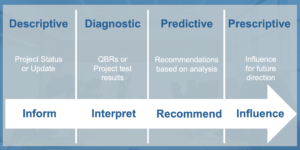Have you ever been asked to deliver a data-driven presentation and it ends up being a tangled mess? You’re not alone.
There are four levels of interpretation for data-driven presentations. These levels range from inform to interpret to recommend to influence. Depending on your goal with the audience (the reason you’re speaking to them) your message structure and approach may change. When you look deeper into these four levels, you’ll notice they fall into two categories of enabling change or promoting change.
What’s your objective?
The question to ask yourself before constructing your message is “Why am I speaking to this audience on this subject? Why should they listen to me?” The answer to these questions will determine how you approach the message structure. Let’s look at all four levels and I’ll give you a message template you can use with each.
Inform
You’ve been asked to give an update on the Alpha Project. Of course, you know the Alpha Project like the back of your hand because you’ve been working on this now for over 3 months. The bi-weekly update meeting is not new to you or your audience. Your audience consists of mid-level managers and Sr. Directors. This group is looking for you to bring the status information to them.
In situations like this, there is not much of an “ask” of the audience. They are the ones who asked you to bring a status report. When you don’t really need anything from the audience, your job is to make the update clear, concise, and complete.
Tool: Good – Bad – New
This model is concise and easy to follow for the audience. We recommend using it for status update presentations because it gives the audience the basic information they want. The Good includes, what is going well. What have you accomplished since the last meeting? The Bad includes, what has gone wrong. What is not going so well? The New includes your next steps and what you will do to fix the bad or prevent it from occurring again.
Interpret
The next level of messaging is the interpretation of the data. In other words, you have an expertise on this subject and the audience needs more than just the data from you. They need an interpretation. What does all of this data mean? It’s the answer to “So what?” As you think about this question, remember to think about it through the lens of the audience. What does all this data mean to the audience? Is there an “aha” discovery that will affect them?
Tool: Situation – Action – Results
This message model is highly flexible and can be used in many messaging situations. We like it for recommendations because it tells the audience how they are affected by the data discovery. The Situation section is used to give the status. Situations often answer several questions like Who? What? When? and Where? The Action describes the corrective options available. The Results tell the audience the expected costs or benefits of each corrective option. Now they have the data with your interpretation of available options and expected impacts.
Recommend
As you move down our messaging spectrum to the recommend category, you’ve crossed over from simply offering helpful information to now offering your suggestions for what the audience should do. This introduces risk to you because you are promoting a singular solution. This is important because you are now attempting to promote change rather than just enable change.
With this target, you are equipping the audience with helpful information and also providing them with the… “If I was you… this is what I would do.” To structure a message like this you will need to consider how the audience feels about your subject before they hear your message.
Tool: What – Why – How
With this model you put more emphasis on the feeling before you give your recommendation. The What is a description of the current situation. It is the reality the audience is facing but they may not even be aware of it yet. The Why focuses on the cost and the importance of the information. You could offer data on how much this situation will hurt ($ or time, etc.) if it is not addressed. The How is your suggestion for which steps can be taken to avoid costs or reach higher goals. You’ve done your part with the recommendation. You took a courageous step and put your name on a path forward. Now, the rest is up to them.
Influence
We’ve arrived at the most challenging messaging goal. You need to share the right information with the audience to move them toward the action you’d like them to take. When the message is done right, you don’t need any formal authority to influence an audience. First, please understand there is a world of difference between influence and manipulation. The first is quite noble and used by all great leaders. The second is pure evil and used only for selfish reasons, usually at the harm of others. We are talking about influence here.
Tool: The Change Narrative
We’ve arrived at the most challenging messaging goal. The focus here is on sharing the right information with the audience to move them toward the action you want them to take. When the message is done right, you don’t need any formal authority to influence an audience.
• Negative Story – Sets the stage for the situation and why it is compelling
• Situation – Relate the negative story to the current situation
• Action – Provide the action steps that must be taken to correct this
• Results – Give the positive results to be found in the future
• Inspiring Story – Leave the audience with the inspiring story
We never said it was easy…
But, it is manageable. The next time you are faced with a data-driven presentation, consider which of the four destinations you'd like to take the audience. Is your goal to Inform, Interpret, Recommend, or Influence? Then, choose the right message template that plays into your hand.
Until next time…
Russ Peterson Jr.
Russ Peterson Jr. is the co-founder and President of iSpeak, Inc. – An award-winning professional development training company. Russ is a speaker, international trainer, and published author on Professional Sales Communication and Business Communication. He delivers workshops, keynotes, and personal communication coaching services to business professionals in the US and around the world. iSpeak helps people build stronger relationships and achieve more through better communication. You can connect with Russ directly through LinkedIn.
P.S. Will you be at ATD22 in Orlando on May 16-18?
If so, come by our booth (#1036) and say howdy! If you mention you read this invite we’ll give you a free hard-cover edition of our presentation messaging book Corporate Ovations. See you in a few weeks!





 4 Messaging Approaches for Data Analysts
4 Messaging Approaches for Data Analysts